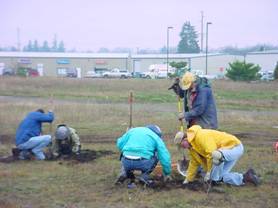Along the south edge of Puget Sound was a landscape unusual to the Pacific Northwest. In place of steep mountains and massive, closed canopied forests, were open, rolling grasslands interwoven with oak savannas, pine woodlands, and rich wetlands. Wildflowers and their resplendent blooms added a rainbow of color to the prairies. From the purples and pinks of violets, camas and rose checkermallow, to the yellows of Puget balsamroot and golden paintbrush, a charming and graceful landscape emerged.
The South Puget Sound prairie landscape used to extend from just south of Tacoma to the Chehalis River drainage site located in the southwest region of Oakville , follow this link to view a map of this historic landscape. Freshwater lakes and wetlands sprinkled the region, while the Nisqually, Deschutes and Black Rivers traversed the landscape. The prairie supplies a unique composition of porous soils formed from glacial outwash, drought conditions and Native American fires that were set to maintain the grasslands for hunting and planting. This maintenance kept the Douglas-fir and other encroaching plants from invading the area, and turning it into forested land.
Current Status
 There are a number of ongoing threats to the South Puget Sound Prairies. What was once 150,000 acres of prairie landscape and habitat has been reduced by 90%, with only 3% of that remaining as pristine prairie. Seven identified prairie sites have been set aside for conservation, follow this link to view a map of the current landscape. There are a number of ongoing threats to the South Puget Sound Prairies. What was once 150,000 acres of prairie landscape and habitat has been reduced by 90%, with only 3% of that remaining as pristine prairie. Seven identified prairie sites have been set aside for conservation, follow this link to view a map of the current landscape.
The remaining areas continue to be replaced by development, agriculture and the invasion of Douglas-fir, Scotch broom and other plants; plants that are not only changing the face of the landscape but the structure as well. All of these disturbances have threatened the prairies native wildlife. There are now a myriad of rare species as a result of this declining habitat.
Ongoing Threats
The following have been identified as ongoing threats to the prairie and oak woodland habitats:
-
The continued plowing of these lands for agriculture or land development,
-
The continued encroachment of non-native and native plants onto the prairies,
-
The fact that these prairies and oak woodlands are now small and isolated from each other.
-
The lack of periodic fires which suppresses invasive plants.
|



